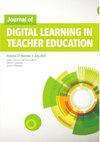Instructional practices promoting computational thinking in STEAM elementary classrooms
Q1 Social Sciences
Journal of Digital Learning in Teacher Education
Pub Date : 2022-06-23
DOI:10.1080/21532974.2022.2087125
引用次数: 2
Abstract
Abstract We examine how elementary STEAM (science, technology, engineering, art, and mathematics) teachers designed and implemented instructional practices to encourage computational thinking (CT) during problem-solving activities. After teachers created STEAM lessons aligned with state standards and CT practices, students made artifacts while solving problems related to science, English-Language Arts, Art and music. Students used digital tools such as Scratch, Hummingbirds, Spheros, littleBits, Lego Robotics and 3-D modeling software. Teachers’ instructional practices included recognizing CT opportunities, building collaborative culture, helping students make connections and designing with limited materials. Students drew on prior experiences, verbalized CT practices, recognized peer expertise and were comfortable with failure. We discuss ways to extend CT learning, broaden participation and improve elementary teachers’ capacity to integrate CT into instruction.STEAM小学课堂中促进计算思维的教学实践
摘要我们研究了STEAM(科学、技术、工程、艺术和数学)小学教师如何设计和实施教学实践,以鼓励在解决问题的活动中进行计算思维(CT)。在老师们创建了符合国家标准和CT实践的STEAM课程后,学生们在解决科学、英语语言艺术、艺术和音乐相关问题的同时制作了人工制品。学生们使用了数字工具,如Scratch、Hummingbirds、Sphereos、littleBits、Lego Robotics和3D建模软件。教师的教学实践包括认识CT机会、建立合作文化、帮助学生建立联系以及使用有限的材料进行设计。学生们借鉴了以往的经验,口头阐述了CT实践,认可了同行的专业知识,并对失败感到满意。我们讨论了如何扩大CT学习,扩大参与,提高小学教师将CT融入教学的能力。
本文章由计算机程序翻译,如有差异,请以英文原文为准。
求助全文
约1分钟内获得全文
求助全文
来源期刊

Journal of Digital Learning in Teacher Education
Social Sciences-Education
CiteScore
4.90
自引率
0.00%
发文量
15
 求助内容:
求助内容: 应助结果提醒方式:
应助结果提醒方式:


